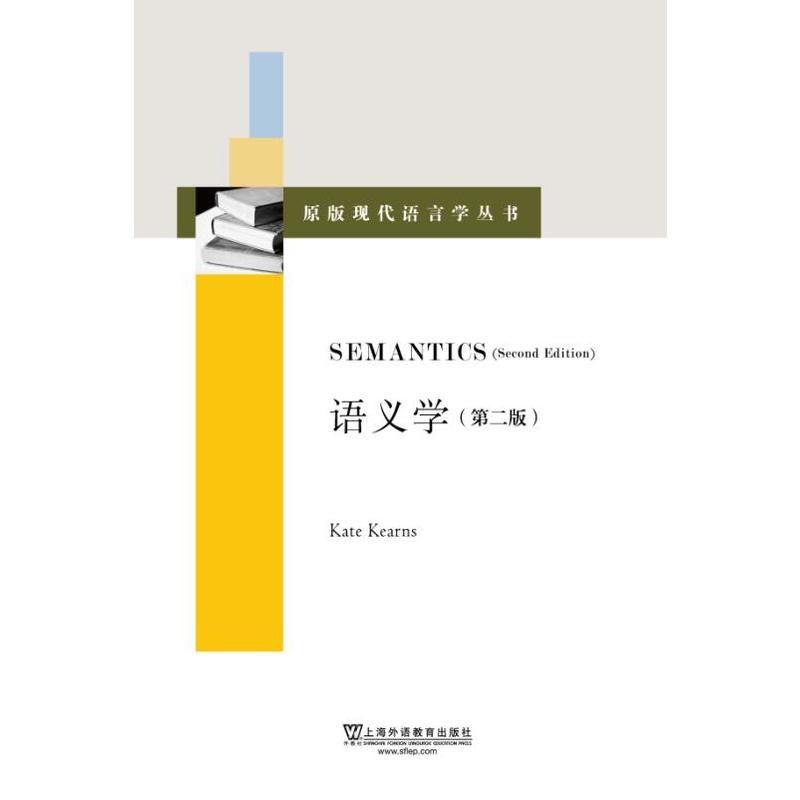买过本商品的人还买了
暂无评论
图文详情
- ISBN:9787544645058
- 装帧:一般胶版纸
- 册数:暂无
- 重量:暂无
- 开本:24cm
- 页数:269
- 出版时间:2016-09-01
- 条形码:9787544645058 ; 978-7-5446-4505-8
内容简介
本书是国际著名学术出版社英国帕尔格雷夫麦克米伦出版的现代语言学教材, 以深入浅出、浅显易懂的语言, 对当代形式语义学的基本概念、研究工具和研究选题进行了详细的介绍, 适合对形式语义学没有任何背景的读者。每章均提供精心设计的分级练习、讨论题和延展阅读, 可以帮助学
目录
AcknowledgementsPreface to the First EditionPreface to the Second Edition1 Introduction 1.1 Semantics and pragmatics 1.2 Kinds of meaning 1.2.1 Denotation and Sense 1.2.2 Lexical and structural meaning 1.2.3 Categorematic and syncategorematic expressions 1.3 Truth-conditional theories of meaning 1.3.1 Denotations 1.3.2 Possible worlds, extension and intension 1.3.3 Truth conditions 1.3.4 Truth-based relations between statements 1.4 Implicature 1.4.1 The Principle of Relevance 1.4.2 The Principle of Informativeness 1.5 Other contextual factors: indexicality and anaphors 1.6 Presupposition Exercises Further Reading2 Basic Logical Tools 2.1 Representations for meanings 2.2 The logical connectives 2.2.1 Conjunction 2.2.2 Negation 2.2.3 Disjunction 2.2.4 The material implication connective 2.2.5 The biconditional connective 2.3 Predicates and arguments 2.3.1 Predicates, verbs and the number of arguments 2.3.2 Sentences as arguments 2.3.3 Path arguments Exercises Further Reading3 The Logical Quantifiers 3.1 The universal quantifier 3.2 The existential quantifier 3.3 Intersective and non-intersective adjectives 3.4 The logical quantifiers are interdefinable 3.5 Scope and scopal ambiguity 3.5.1 Scope and tree diagrams 3.5.2 Scopal ambiguity Exercises Further Reading4 Formal Composition 4.1 Types 4.2 Functions 4.3 Types of function 4.4 Lambda abstraction 4.5 Some general rules for semantic composition 4.6 Predicate variables Summary of rules and definitions Exercises Further Reading5 Modality and Possible Worlds 5.1 Kinds of modality 5.1.1 Logical modality 5.1.2 Epistemic modality 5.1.3 Deontic modality 5.2 Modality and possible worlds 5.2.1 Logical modality and possible worlds 5.2.2 Epistemic modality and possible worlds 5.2.3 Deontic modality and possible worlds 5.2.4 Interdefinability with negation 5.3 Counterfactuals Exercises Further Reading6 Generalized Quantifiers 6.1 Quantification beyond first order logic 6.2 Generalized Quantifier Theory 6.3 Different types of quantifier determiner 6.3.1 Group 1 and Group 2 determiners 6.3.2 The ambiguity of few and many 6.3.3 Few and a few 6.3.4 Some and several 6.4 Restricted quantifier notation 6.5 Scopal ambiguity 6.6 Proportional determiners and discourse familiarity 6.7 Strong and weak determiners and there BE sentences 6.7.1 The definiteness effect 6.7.2 Types of there BEsentence 6.8 Determiner the and definite descriptions 6.8.1 Russell's Theory of Descriptions 6.8.2 The as a generalized quantifier 6.8.3 Definite descriptions as strong NPs Familiarity effects Definite descriptions in there BE contexts Definite descriptions and scopal ambiguity 6.9 Quantifiers and negative polarity items 6.10 Generalized quantifiers as lambda functions Exercises Further Reading7 Referential Opacity 7.1 Quine's referential opacity 7.2 Modality, descriptions and names 7.2.1 Modality and names 7.2.2 Modality and descriptions 7.3 Propositional attitudes and descriptions 7.4 Summary: descriptions and scope 7.5 Propositional attitudes and names 7.6 De re and de dicto readings with other quantifiers 7.7 Indefinite descriptions and specificity Exercises Further Reading8 Aktionsarten: Aspectual Classes of Events 8.1 Vendler's four aspectual classes 8.2 Diagnostic tests for aktionsarten 8.2.1 In adverbials 8.2.2 The take time construction 8.2.3 For adverbials 8.2.4 The sub-interval property 8.2.5 Entailments of the progressive 8.2.6 Duration and the progressive 8.3 Telicity and boundedness 8.4 Semelfactive predicates 8.5 Aktionsarten and agentivity 8.6 Nominal and verbal aspect 8.7 Closing comment Exercises Further Reading9 Tense and Aspect 9.1 Introduction 9.2 The English verb group 9.3 Interpretations of present, past, progressive and perfect 9.3.1 Interpretations of the present tense 9.3.2 Interpretations of the past tense 9.3.3 Other forms for future and habitual 9.3.4 Interpretations of the progressive 9.3.5 Interpretations of the present perfect Present time adverbials Current result states 'Hot news' perfect Continuing state 9.4 Tense as an operator 9.5 Tense and reference to times 9.6 Reichenbach's analysis of tense 9.7 Reference to times in a narrative 9.7.1 Reference time movement 9.7.2 State/progressive includes reference time:reference time includes bounded event 9.7.3 Is r the same as Reichenbach's R?
9.7.4 General principles for temporal interpretation in narrative 9.7.5 Adding tense 9.8 Closing comment Exercises Further Reading10 Thematic Roles and Lexical Conceptual Structure 10.1 Introduction 10.2 Traditional thematic roles 10.2.1 Agent/Actor and Patient 10.2.2 Localist roles 10.2.3 Recipient and benefactive 10.2.4 Experiencer and stimulus 10.2.5 Do adjuncts have thematic roles?
10.2.6 Themes and Patients 10.2.7 Summary 10.3 More detailed analysis of thematic roles 10.4 Lexical conceptual structure and thematic roles 10.4.1 The action tier 10.4.2 Theme, goal and location 10.4.3 Experiencer and stimulus 10.4.4 Motion event roles 10.4.5 Recipient find benefactive 10.4.6 Summary oftheta roles in LCS 10.5 Verb classes and LCS 10.6 Closing comment Summary of LCS symbols and definitions with selected examples Exercises Further Reading11 Events 11.1 Davidson's analysis of action sentences 11.2 Neodavidsonian developments 11.2.1 Separation of direct arguments 11.2.2 Relations to events 11.2.3 The adicity of verbal predicates 11.3 Events and perception verbs 11.4 Adding tense and NP quantifiers Exercises Further ReadingBibliographyIndex
展开全部
本类五星书
浏览历史
本类畅销
-

文言浅说
¥11.0¥24.0 -

乡土中国
¥18.5¥26.0 -

偏见
¥21.8¥56.0 -

饥饿、富裕与道德
¥12.2¥45.0 -

一个西方传教士的长征亲历记
¥15.7¥49.0 -

从白大褂到病号服:探索医疗中的人性落差
¥13.7¥39.8 -

身为女性的选择
¥25.2¥56.0 -

人际交往心理学
¥10.5¥38.0 -

西方哲学史
¥14.8¥38.0 -

性心理学
¥18.4¥58.0 -

女性生存战争
¥26.1¥66.0 -

社会学:原来这么有趣有用
¥10.0¥36.0 -

咬文嚼字二百问
¥13.2¥32.0 -

蛤蟆先生去看心理医生
¥23.8¥38.0 -

中国人的名·字·号
¥10.0¥28.0 -

我们内心的冲突(平装)
¥13.8¥39.9 -

我们内心的冲突
¥14.4¥42.0 -

乌合之众:群体心理研究
¥12.9¥39.8 -

看不见的伤痕(八品-九品)
¥23.1¥69.0 -

第二性Ⅰ//2021新定价
¥33.8¥52.0














